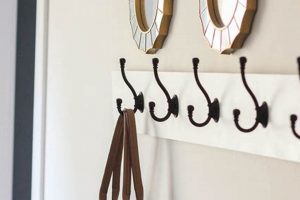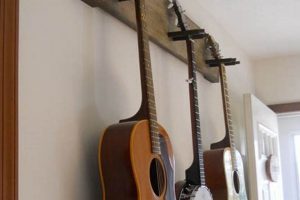The construction of a climbing structure at home offers an accessible avenue for physical activity and skill development. This undertaking typically involves affixing climbing holds to a prepared surface, often a wooden panel, to simulate the experience of rock climbing without the height of traditional climbing. These structures can range in size from small, simple installations suitable for children to larger, more complex designs intended for experienced climbers.
Engaging in such a project provides numerous advantages, including improved physical fitness, enhanced problem-solving skills, and increased accessibility to climbing as a sport or recreational activity. Historically, the creation of these at-home climbing apparatuses stemmed from a desire to train during inclement weather or when access to natural climbing areas was limited. The practice also allows for customization, enabling builders to tailor the difficulty and features of the climbing surface to individual skill levels and training goals. This ability to personalize the climbing experience contributes to sustained engagement and progression in climbing ability.
The subsequent sections will delve into key considerations for planning and executing such a project, including structural design, material selection, safety protocols, and hold placement strategies. Detailed guidance will be provided to ensure a safe and rewarding outcome for those undertaking this endeavor.
Essential Guidelines for At-Home Climbing Structure Construction
The subsequent guidelines serve as critical recommendations for individuals undertaking the construction of a personal climbing structure. Adherence to these points will significantly contribute to the structural integrity, safety, and overall utility of the finished apparatus.
Tip 1: Structural Integrity Assessment: Prior to commencement, conduct a thorough evaluation of the intended supporting structure. Walls should be capable of withstanding significant shear and tensile forces exerted during climbing. Reinforcement may be necessary for inadequate structures.
Tip 2: Panel Material Selection: Opt for high-quality plywood with a minimum thickness of 3/4 inch. Ensure the plywood is free from voids, knots, or other imperfections that could compromise its strength and stability.
Tip 3: Secure Attachment Methods: Employ T-nuts and appropriate bolt lengths for attaching climbing holds. Incorrect bolt lengths can either fail to secure the hold adequately or damage the plywood. Regularly inspect and tighten all bolts to maintain hold stability.
Tip 4: Hold Placement Strategy: Carefully plan the placement of climbing holds to create varied routes and difficulty levels. Consider incorporating both positive and negative holds, as well as varied spacing, to challenge climbers with diverse skill sets.
Tip 5: Safety Matting Installation: Implement a comprehensive safety matting system beneath the climbing structure. Mats should be of adequate thickness and density to provide sufficient impact absorption in the event of a fall. Regularly inspect mats for wear and tear.
Tip 6: Height Considerations: Limit the overall height of the climbing structure to mitigate the risk of serious injury from falls. Consider the skill level and experience of the intended users when determining the appropriate height.
Tip 7: Routine Inspection and Maintenance: Establish a schedule for routine inspection and maintenance of the climbing structure. This includes inspecting holds for damage, tightening bolts, and assessing the condition of the safety matting. Promptly address any issues identified during inspection.
These recommendations are intended to enhance the safety and longevity of the climbing structure. Diligent adherence to these guidelines will promote a positive and injury-free climbing experience.
The following sections will address more specific aspects of climbing structure design and utilization.
1. Structural Integrity
Structural integrity constitutes a fundamental and non-negotiable aspect of any climbing structure constructed at home. The capacity of the structure to withstand the dynamic forces exerted during climbing activities is directly linked to climber safety and the longevity of the climbing surface. Failure to adequately address structural integrity can lead to catastrophic collapse, resulting in serious injury or even fatality. The climbing structure must be designed and built to endure not only static loads, but also the sudden and unpredictable forces generated by climbers shifting their weight and momentum. This requires careful consideration of the supporting framework, attachment points, and the properties of the materials used.
A practical example of the importance of structural integrity can be seen in the consequences of using inadequate framing materials. If undersized lumber or improperly joined supports are utilized, the climbing structure may exhibit excessive flex or deformation under load. This, in turn, can compromise the security of the climbing holds, potentially causing them to detach from the wall and creating a hazardous situation for the climber. Similarly, if the climbing wall is attached to an existing building structure, the load-bearing capacity of that structure must be carefully assessed to ensure it can accommodate the additional stress imposed by the climbing wall. Consulting with a structural engineer is often advisable in complex installations or when there is uncertainty about the existing structure’s capabilities. An appropriate frame will equally spread the load evenly.
In summary, structural integrity is not merely a desirable feature but rather an essential prerequisite for a safe and functional climbing structure. Careful planning, selection of appropriate materials, and adherence to sound construction principles are crucial for ensuring that the structure can withstand the rigors of climbing activities. Addressing structural integrity comprehensively mitigates risk and maximizes the safety and enjoyment of the climbing experience. Proper design principles in structural integrity reduces the burden in the frame of climbing surface that ensures longevity. A well-built structure inspires confidence and promotes a positive and safe climbing environment.
2. Plywood Thickness
Plywood thickness is a critical determinant of the structural integrity and overall safety of a climbing wall constructed at home. The selection of an appropriate thickness directly influences the capacity of the wall to withstand the forces exerted during climbing activities. Insufficient thickness may lead to flexing, cracking, or even complete failure of the panel, posing a significant risk to the climber. The standard recommendation for climbing walls is a minimum of 3/4-inch thick plywood; however, in situations where the support structure is widely spaced or the wall will be subjected to particularly heavy use, a greater thickness may be warranted. Using under-spec plywood often results in climbing holds ripping off or destabilizing, making it dangerous.
The thickness of the plywood is intrinsically linked to the method of attaching climbing holds. T-nuts, which are commonly used to secure holds, require sufficient plywood thickness to provide adequate embedment depth. If the plywood is too thin, the T-nuts may pull through the panel under load, rendering the hold unusable and creating a potential fall hazard. Furthermore, flexing of thinner plywood can exacerbate this issue by loosening the T-nuts over time. For instance, a climbing wall constructed with 1/2-inch plywood may initially appear adequate, but repeated use will likely result in hold failures and necessitate costly repairs or complete replacement of the panels.
In summary, the selection of appropriate plywood thickness is a fundamental decision in the construction of a climbing wall at home. It directly impacts the wall’s strength, safety, and longevity. While thicker plywood represents a greater initial investment, it ultimately provides enhanced security, reduces the risk of failure, and minimizes long-term maintenance costs. The seemingly small difference in thickness represents a critical factor in the overall performance and safety profile. Ignoring this detail can turn an enjoyable and healthy activity into a significant safety hazard. Prioritizing this ensures maximum benefit in the long run.
3. T-nut Security
T-nut security is paramount for the safe and reliable operation of any at-home climbing structure. T-nuts serve as the primary anchor points for climbing holds, effectively transferring the climber’s weight and force to the plywood panel. A compromised T-nut connection can lead to sudden hold failure, resulting in falls and potential injuries. The construction of an effective climbing structure necessitates careful attention to the selection, installation, and maintenance of these critical components. Selecting high-quality T-nuts with adequate flange size and thread depth is the first step towards ensuring a secure connection. Proper installation, involving a flush and secure seating of the T-nut within the plywood, is equally crucial. Regular inspection and tightening of the bolts that secure the holds to the T-nuts are essential for preventing loosening due to vibration and repeated loading.
The consequences of neglecting T-nut security can be severe. For instance, repeated use of a climbing wall can cause the plywood around a poorly installed T-nut to compress or splinter, leading to a gradual loosening of the connection. Over time, this loosening can result in the T-nut pulling through the plywood, causing the attached hold to detach unexpectedly. Such failures not only interrupt the climbing experience but also pose a significant safety risk. Furthermore, the location of the T-nut within the climbing wall design can impact its security. T-nuts positioned near the edges of the plywood panel or in areas of high stress concentration are more susceptible to failure than those located in more stable areas. Therefore, careful consideration should be given to hold placement to minimize stress on individual T-nuts.
In conclusion, T-nut security is an indispensable element of any undertaking where the aim is to build a climbing surface at home. Prioritizing the selection of high-quality components, meticulous installation techniques, and diligent maintenance practices is essential for mitigating the risk of hold failures and ensuring a safe climbing environment. While seemingly small and insignificant, the T-nut represents a critical link in the chain of safety and reliability. Neglecting this aspect compromises the entire system, underscoring the importance of attention to detail in the design and construction of climbing structures.
4. Fall Protection
The implementation of adequate fall protection is an indispensable element in the construction of any at-home climbing structure. Bouldering, by its nature, involves climbing without ropes to a limited height, making falls an inevitable occurrence. Consequently, the provision of suitable protective measures to mitigate the impact of these falls is a critical safety consideration. The absence of effective fall protection can lead to serious injuries, ranging from sprains and fractures to head trauma. The primary objective is to create a landing zone that effectively absorbs energy and minimizes the risk of injury upon impact.
A prevalent example of inadequate fall protection involves the use of thin or improperly placed mats. If the mats are insufficiently thick or lack adequate density, they will fail to provide adequate cushioning, potentially leading to bone fractures or joint injuries. Conversely, the improper placement of mats, leaving gaps or uneven surfaces, can create tripping hazards or concentrated impact points, increasing the risk of ankle sprains or other lower extremity injuries. The selection of appropriate matting materials is also essential, with closed-cell foam being preferable due to its superior impact absorption and durability. Furthermore, the surrounding environment should be carefully assessed to identify and eliminate any potential hazards, such as sharp edges or protruding objects, that could exacerbate the severity of a fall.
In summary, fall protection is not merely an optional add-on but rather an intrinsic component of a safe and functional climbing structure at home. The provision of adequate matting, coupled with a thorough assessment and mitigation of environmental hazards, is paramount for minimizing the risk of injury. Neglecting these measures compromises the safety of the climbing environment and increases the likelihood of adverse outcomes. Thus, careful planning and implementation of robust fall protection strategies are essential for promoting a positive and injury-free climbing experience. The cost of not implementing can be substantial in terms of health care costs, lost productivity, and emotional distress.
5. Hold Variety
The composition of climbing holds significantly influences the functionality and training efficacy of a climbing structure constructed at home. Diversification in hold type is not merely an aesthetic consideration but directly affects the physical and technical demands placed upon the climber. The selection and arrangement of holds should be carefully considered to create a balanced and challenging climbing experience.
- Skill Development
A varied hold selection promotes the development of a wider range of climbing techniques. Slopers, pinches, crimps, and jugs each require distinct hand and body positions, fostering adaptability and technical proficiency. Limiting the hold types restricts skill acquisition and can lead to plateaus in climbing ability.
- Strength and Endurance
Different hold types engage different muscle groups. Crimps primarily target finger strength, while slopers require significant forearm engagement and body tension. A diverse hold selection ensures a more balanced workout, promoting overall strength development and reducing the risk of overuse injuries. For example, a lack of larger, more positive holds can overemphasize finger strength, potentially leading to tendonitis.
- Route Creation
Hold variety enables the creation of more diverse and challenging routes. The combination of different hold types, orientations, and spacing allows for the design of problems that test a wide range of climbing skills. This adaptability is particularly valuable in an at-home environment where the climbing area is typically limited. A diverse selection promotes creativity and prevents stagnation.
- Injury Prevention
Using only one type of hold during climbing sessions on a “diy bouldering wall” can increase the risk of overuse injuries. Repeatedly stressing the same muscles and tendons can lead to inflammation and pain. Variety allows the climber to distribute the workload across different muscle groups, reducing the likelihood of repetitive strain injuries. Alternating between crimps, slopers, and pinches is a simple strategy to mitigate this risk.
In conclusion, strategic hold selection is essential for maximizing the benefits and minimizing the risks associated with a climbing structure constructed at home. A diverse range of hold types promotes skill development, enhances strength and endurance, facilitates creative route setting, and contributes to injury prevention. Integrating these insights enhances the overall value of an at-home climbing facility.
Frequently Asked Questions Regarding At-Home Climbing Structures
The following section addresses common inquiries and concerns pertaining to the construction and utilization of climbing structures within a residential setting. These answers provide clarity on essential aspects of safety, design, and maintenance.
Question 1: What is the minimum recommended ceiling height for a safe climbing structure?
The minimum recommended ceiling height is contingent upon the intended users and their skill level. However, a ceiling height of at least 8 feet is generally advised to accommodate a bouldering wall with adequate fall protection. Taller walls necessitate proportionally increased ceiling heights and expanded landing zones.
Question 2: What type of wood is best suited for constructing a climbing wall?
High-quality plywood, specifically CDX or better, with a minimum thickness of 3/4 inch, is the preferred material. The plywood should be free from voids, knots, and other imperfections that could compromise its structural integrity. Marine-grade plywood offers superior resistance to moisture but is typically more expensive.
Question 3: How often should climbing holds be inspected and tightened?
Climbing holds should undergo routine inspection and tightening at least once per month, or more frequently in high-use environments. Loose holds pose a significant safety hazard and should be addressed immediately.
Question 4: What is the recommended thickness for safety mats beneath a climbing structure?
Safety mats should have a minimum thickness of 4 inches and be constructed from high-density foam designed to absorb impact. The mats should extend beyond the perimeter of the climbing wall to provide adequate coverage in the event of a fall. Regular inspection for wear and tear is essential.
Question 5: How can the risk of overuse injuries be minimized when using a climbing structure?
The risk of overuse injuries can be mitigated through varied hold selection, strategic route setting, and adherence to proper warm-up and cool-down routines. Additionally, limiting climbing duration and incorporating rest days into the training schedule is crucial for preventing repetitive strain injuries.
Question 6: Is professional consultation recommended before building a climbing structure?
Professional consultation with a structural engineer or experienced climbing wall builder is highly recommended, particularly for complex designs or when attaching the climbing structure to an existing building. Expert guidance can ensure structural integrity and adherence to safety standards.
Adherence to these guidelines will contribute significantly to the safety, longevity, and functionality of the climbing structure. Careful planning and execution are paramount for a successful outcome.
The subsequent section will provide insights into advanced climbing training techniques using “diy bouldering wall”.
Concluding Remarks on Home Climbing Structure Construction
The foregoing analysis has presented a comprehensive overview of critical considerations for the successful design, construction, and utilization of a climbing structure at home. The importance of structural integrity, appropriate material selection, secure hold attachment, fall protection measures, and hold diversification has been thoroughly emphasized. Adherence to these principles is paramount for ensuring the safety and longevity of the climbing structure, as well as maximizing its potential for physical and technical training benefits. Improper implementation of any of these components can have deleterious consequences, ranging from structural failure to user injury. Therefore, meticulous planning and execution are non-negotiable.
Ultimately, the construction of a “diy bouldering wall” represents a significant undertaking that demands a commitment to safety, precision, and ongoing maintenance. While the potential rewards, including enhanced fitness, skill development, and accessibility to the sport of climbing, are substantial, these benefits can only be realized through responsible and informed practices. Individuals considering this endeavor must prioritize safety above all else, consulting with qualified professionals when necessary, and adhering to established best practices for construction and use. The future of accessible climbing training lies in the responsible implementation and innovation of these home climbing solutions.







